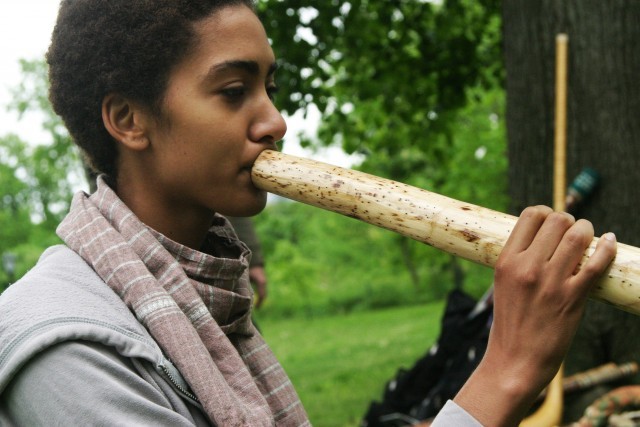The first practice for didgeridoo playing, connecting with your breath, will give you a better understanding of the respiratory system and lay a strong foundation for your training. These exercises are designed to connect you to your breath and prepare you for didgeridoo playing. We recommend spending some time learning these breathing techniques before you start practicing the didgeridoo as you will be much better prepared for the physical exertion required.
Start with the following:
Take three deep breaths and notice where in your body the breath is creating movement. Perhaps in your chest, belly or shoulders or elsewhere.
The study of wind instruments shows that breathing immediately into the upper chest does not utilize the full potential of the respiratory system and often results in short, weak breathing. The information contained here is what will allows you to inhale many times longer and play notes on didgeridoo for over one minute on a single breath.
One of the most important techniques in the mastery of wind instruments is diaphragmatic breathing, also known as belly breathing or abdominal breathing. This type of breathing generates more powerful airflow, expands the lung capacity and is useful for general relaxation and stress-reduction. Diaphragmatic breathing is performed as follows:
On the inhalation the belly expands, moving forward from the front of the body, and on the exhalation the belly contracts, moving toward the spine.
Try visualizing the belly as a balloon: as you inhale the belly fills with air and as you exhale it deflates.

Anatomy of Breathing
The belly is a great indicator of whether or not you are performing diaphragmatic breathing correctly. To truly master this breath, a more complete understanding of the diaphragm is essential.
First try this:
With both hands, touch the bottom of your sternum (breast-bone) at the center of your rib cage. Now using your fingertips, follow the bottom ribs down and around to your sides. Notice how low your ribs go, just a few inches away from the top of your pelvis (hip bone).
Understanding The Breathing Muscles
The primary muscles used in breathing are the diaphragm, abdominal and intercostal muscles, collectively known as the “breathing muscles.”
The diaphragm is a dome-shaped muscle that lines the bottom of the rib cage. When you inhale, the diaphragm contracts, flattening from its parachute-shape downwards. This motion creates a vacuum in the lungs, draws in air and pushes down upon the stomach, intestines and other organs, causing the belly to swell out (seemingly inflating like a balloon).
When you exhale, there is contraction in both the abdominal muscles (the “abs”) and intercostal muscles (which surround the ribs), allowing the diaphragm to relax upward back into its dome shape. In brief, the diaphragm contracts (works) when you inhale and relaxes when you exhale.
The abdominal muscles are the primary force behind exhalation, especially for the strong that needed to play a wind instrument. See if you can feel your abdominal muscles working with the following exercise:
Imagine you are about to blow out a candle. Take a relaxed inhalation that expands your belly and then give an abrupt breath out: whoosh! When you perform this abrupt motion you should be able to feel the abs in action. The sensation of the abs contracting should feel like a tightening sensation in your belly. Repeat this a few times. Note that as you exhale the diaphragm is relaxing.
Now that you have an awareness of the breathing muscles, the following exercise is the best way to practice diaphragmatic breathing:
Put one hand on your chest and one hand over your belly. Take slow relaxed breaths, inhaling and exhaling for as long as you can, visualizing your belly as a balloon. If you are doing the diaphragmatic breath correctly, then your lower hand should feel the belly inflate with each inhale and deflate with each exhale while the upper hand feels the chest and shoulders remain relatively relaxed and neutral. The hands should not push or pull at all. Once you understand the concept of diaphragmatic breathing, this exercise should be practiced for ten minutes a day until you have fully internalized it.
***Use a mirror to make sure your chest and shoulders stay mostly relaxed while your belly expands.
Watch a video demonstration of diaphragmatic breathing exercises:
Expanding Lung Capacity
Wind instrumentalists who have developed their lung capacity can play a note over a minute in length on a single breath. What follows is the technique that will get you to exhale much longer than you may have thought yourself capable. In addition to playing longer notes, expanding your lung capacity will make learning the didgeridoo much easier.
The primary technique used to expand lung capacity is:
Inhale as slow as you can until your lungs are completely full. Once full, hold for a second and then breathe out as slow as you can until your lungs are completely empty. Hold your lungs empty for a second and then repeat by starting your next inhalation.
To properly perform this lung expanding exercise it is important to slow down the rate of airflow. Your goal here is to make each breath last longer than the previous one.
To optimize the efficacy of this practice, it is important to simulate the back-pressure (resistance) of a wind instrument by constricting the opening through which the air flows out the mouth. This resistance will make each breath last even longer. There are two ways to practice this: through pursed lips (leaving only a very small mouth opening) or through a straw.
The key to this exercise is to make each inhale and exhale as long and slow as possible and go beyond where you think you are full or empty. If you correctly practice this for 10 to 15 minutes per day you will find that your lung capacity is much greater than when you started.
***Please be sensitive to your natural limits. If inhaling to maximum capacity or exhaling to maximum emptying of the lungs causes pain, please stop this exercises. Discomfort is natural when you are challenging yourself but pain is not. Do not put yourself into a painful situation.














Glad to see you sharing your awesome gift ,)))))cheers alexander
Thank you for the education you are providing. I can play the didge and have done so for many years. I ask, how to increase the back pressure, in some didgeridoos the air feels that thick you can almost chew it making playing easy, in others, no back pressure making playing quite hard and labor intensive. I can’t afford to purchase more didgeridoos trying to find the correct back pressure for my body, any help will be so appreciated, Michael
This is great!! And I think, with the slightest of adjustment, that the exercises also translate into better breath support for singers as well. Thanks for sharing.